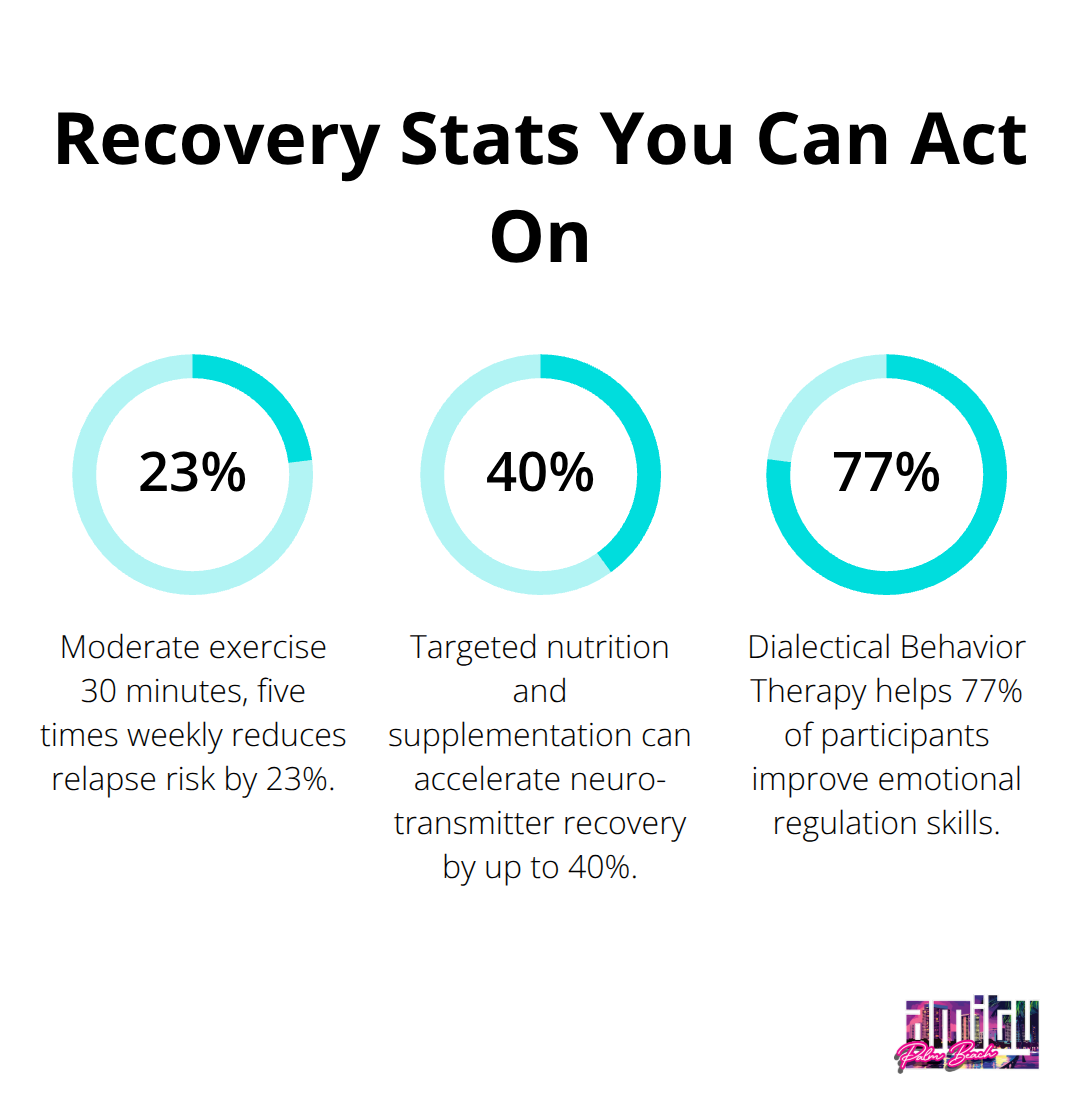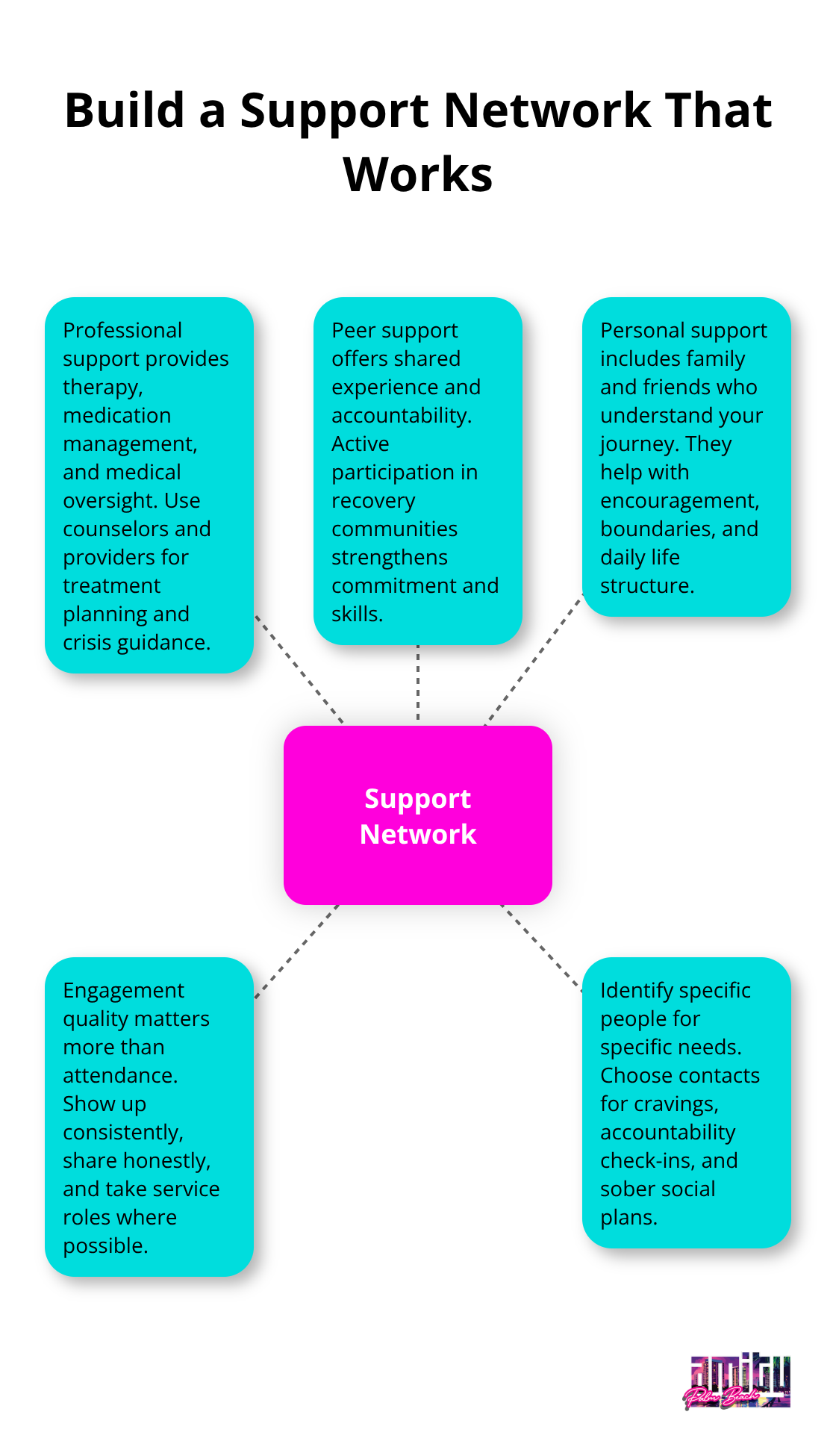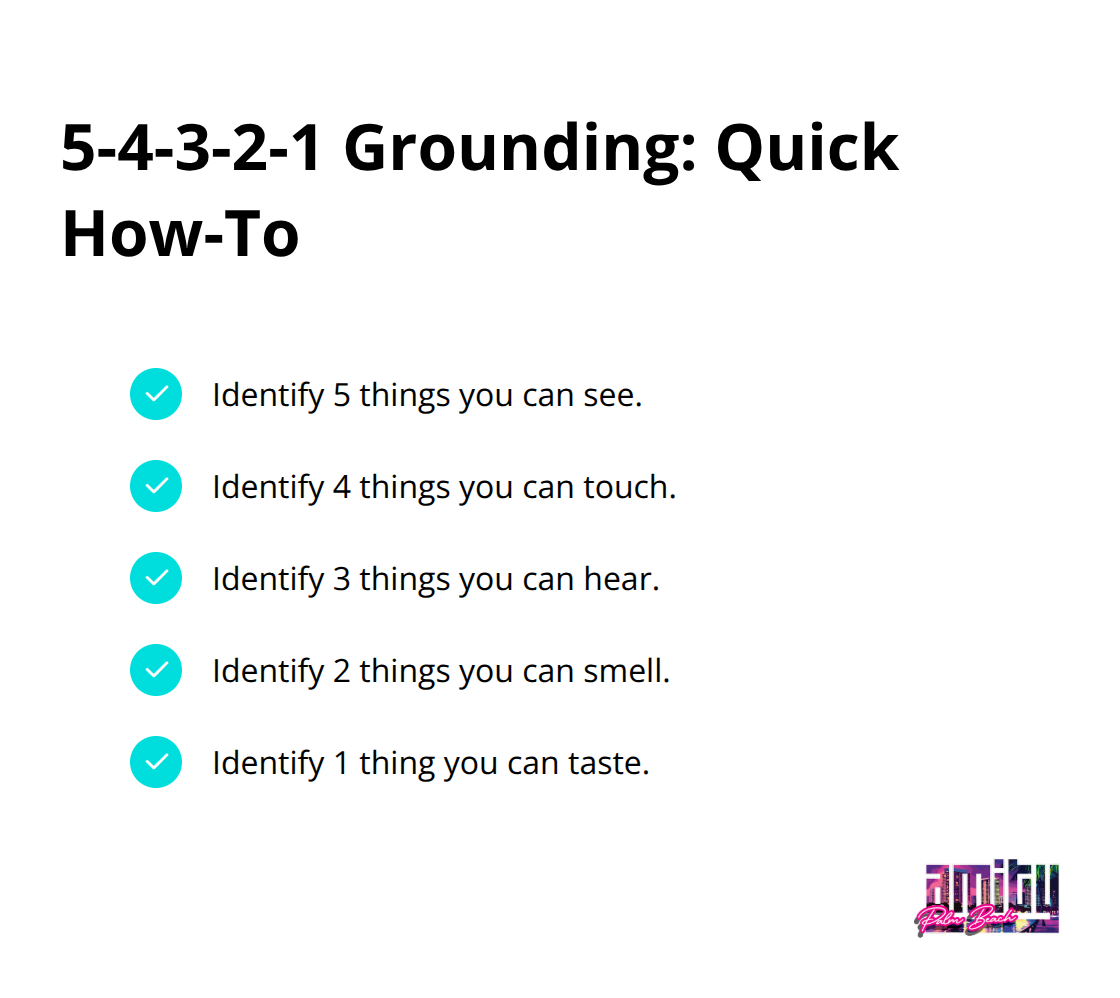Living in recovery from addiction marks the beginning of a transformative chapter, not the end of your story. The path ahead involves rebuilding your life with intention and purpose.
We at Amity Palm Beach understand that recovery extends far beyond completing addiction treatment. This journey requires practical strategies, ongoing support, and a clear understanding of what sustainable recovery truly looks like.
What Does Recovery Actually Look Like
Recovery operates as an active, daily commitment rather than a fixed achievement you reach and maintain effortlessly. According to SAMHSA’s 2021 survey, 72.2% of adults with substance use issues consider themselves in recovery, yet this statistic reveals something important: recovery exists on a spectrum of ongoing engagement, not as a binary state.
Your brain requires time to begin normal dopamine function restoration, but emotional and psychological healing extends far beyond this initial period. The National Institute on Drug Abuse reports that effective treatment must last at least 90 days, though many individuals benefit from longer-term support that lasts six months to several years.
Physical Restoration Takes Time
Your body undergoes measurable changes during recovery that extend well beyond initial detox. Sleep patterns typically require 3-6 months to normalize, while cognitive function improvements continue for up to two years. Nutrition plays a direct role in brain restoration – studies show that proper vitamin B complex, omega-3 fatty acids, and amino acid supplementation can accelerate neurotransmitter recovery by up to 40%.
Regular exercise produces natural endorphins that help combat depression and anxiety, with research that indicates 30 minutes of moderate activity five times weekly reduces relapse risk by 23%. Many people expect to feel completely normal within weeks, but physical restoration follows a predictable timeline that cannot be rushed through willpower alone.

Mental and Emotional Restoration Requires Active Work
Mental health recovery involves the rewiring of thought patterns and emotional responses that developed over years of substance use. Cognitive Behavioral Therapy shows effectiveness rates of 60-70% when combined with ongoing support, while Dialectical Behavior Therapy helps 77% of participants develop better emotional regulation skills.
The myth that you should feel grateful and positive immediately after treatment creates unrealistic expectations. Depression, anxiety, and irritability remain common for 6-18 months as your brain chemistry stabilizes (this timeline varies significantly between individuals). Professional counseling, medication management when appropriate, and peer support groups provide the structure needed for sustainable emotional wellness.
Common Misconceptions About Recovery Life
Recovery means you learn to experience difficult emotions without substances, not that you eliminate all discomfort from your life. Many people believe that successful recovery equals constant happiness or that cravings disappear completely after treatment. Research shows that occasional cravings can persist for months or even years, particularly during stress or major life changes.
Another persistent myth suggests that people in recovery must avoid all social situations where alcohol is present. While early recovery often requires careful environment management, many individuals eventually develop the skills to navigate various social settings safely (though this varies greatly by person and situation).
The foundation you build during this phase of understanding addiction recovery becomes the cornerstone for developing the practical strategies and support systems that will sustain your long-term success.
How Do You Build a Recovery Foundation That Lasts
Structure becomes your strongest ally in early recovery, yet most people approach it backwards. Instead of creating rigid schedules that feel like prison sentences, successful recovery requires flexible frameworks that adapt to real life while maintain consistency in key areas. Research shows that individuals who establish morning routines within their first 90 days experience better recovery outcomes than those without structured starts to their day.
Your daily framework should center around three non-negotiable elements: consistent sleep schedules, regular meal times, and dedicated recovery activities. Sleep research indicates that you maintain the same bedtime and wake time within 30 minutes daily to help restore natural circadian rhythms within 6-8 weeks. Meal times affect blood sugar stability, which directly impacts mood regulation and craving intensity.
Recovery Activities Need Scheduled Time Slots
Recovery activities include therapy sessions, support group meetings, exercise, or meditation practice – but they must happen at predetermined times, not when you feel like it. The brain responds better to predictable patterns than sporadic efforts (even when motivation runs high).
Try to schedule these activities during times when you historically felt most vulnerable to substance use. Many people discover that late afternoons or early evenings present the highest risk periods, making these ideal times for structured recovery activities.
Support Networks Require Strategic Construction
Meaningful connections demand intentional effort beyond showing up to meetings. SAMHSA data reveals that 2.1 million people participated in self-help groups for substance use in 2019, yet retention rates vary dramatically based on engagement quality. Active participation in recovery communities produces measurably better outcomes than passive attendance.
Your support network needs three distinct layers: professional support from counselors and medical providers, peer support from others in recovery, and personal support from family and friends who understand your journey. The most effective approach involves identifying specific people for specific types of support – someone to call during cravings, someone for accountability check-ins, and someone for social activities that don’t revolve around substances.

Studies show that people with at least five strong recovery connections maintain sobriety at rates approaching 70% after two years. Quality matters more than quantity when you build these relationships.
Trigger Management Starts With Precise Identification
Triggers operate on multiple levels that require different management strategies. Environmental triggers include specific locations, people, or situations that create urges. Emotional triggers involve feelings like stress, loneliness, anger, or even positive emotions like celebration. Physical triggers include fatigue, hunger, or pain that make you more vulnerable to cravings.
The most effective trigger management involves detailed response plans before encounters occur. This means you identify your top five triggers and develop specific, actionable responses for each one. For example, if work stress triggers cravings, your plan might include taking three deep breaths, calling your sponsor, and going for a 10-minute walk.
Research indicates that individuals with written trigger management plans experience fewer relapse episodes compared to those relying on willpower alone. Written plans work because they remove decision-making from high-stress moments.
These foundational elements create the stability needed to navigate the inevitable challenges that arise during early recovery, from managing intense emotions to rebuilding damaged relationships. Understanding the benefits of recovery from addiction can provide additional motivation as you build your personal recovery journey.
How Do You Handle Recovery’s Toughest Moments
Cravings strike hardest when your guard drops, typically during the first 90 days when your brain chemistry remains unstable. Research from Kelly et al. shows that individuals average 6.12 recovery attempts before they achieve lasting sobriety, with opioid users requiring even more at 8.48 attempts. The key lies in understanding that cravings follow predictable patterns – they peak within 3-5 minutes and naturally subside within 20-30 minutes if you don’t act on them.
Effective craving management requires the HALT method: assess if you’re Hungry, Angry, Lonely, or Tired, then address the underlying need immediately. Research shows that people who use specific coping techniques during cravings have better outcomes in avoiding relapse episodes compared to those who rely on willpower alone.
Emotional Regulation Demands Specific Skills
Difficult emotions intensify during early recovery as your brain relearns how to process feelings without chemical numbing. Dialectical Behavior Therapy research shows that individuals who practice distress tolerance skills reduce emotional reactivity by 60% within six months.
The most effective technique involves the 5-4-3-2-1 grounding method: identify 5 things you see, 4 you can touch, 3 you hear, 2 you smell, and 1 you taste. This neurological reset interrupts emotional overwhelm within 2-3 minutes (making it more effective than breathing exercises alone).

Professional counseling becomes essential during this phase, as untreated anxiety and depression contribute to relapse in 50-60% of cases according to research from Havassy et al.
Family Trust Rebuilds Through Measurable Actions
Family relationships damaged by addiction don’t heal through apologies alone – they require consistent behavioral changes over months or years. Research indicates that 23% of individuals in recovery must completely change their social circles to maintain sobriety, which often includes setting boundaries with family members who enable destructive patterns.
The amends process works best when you focus on changed actions rather than explanations of past behavior. Studies show that families who participate in structured therapy sessions during the first year of recovery report 40% higher satisfaction with relationship improvements compared to those who attempt reconciliation without professional guidance.
Work and Social Challenges Need Strategic Plans
Work and social situations demand strategic planning rather than avoidance, as isolation increases relapse risk by 35% according to SAMHSA data. You must develop specific responses for common workplace stressors and social invitations that previously triggered substance use (rather than hoping willpower will carry you through).
Most people underestimate how much their social identity revolved around substance use until they face their first sober weekend or work happy hour. Having emergency contact pages ready provides immediate support during difficult moments, while preparation beats improvisation in these high-risk scenarios.
Final Thoughts
Living in recovery from addiction transforms into a lifelong process of personal growth that extends far beyond initial treatment completion. Research shows that individuals who maintain recovery for two years still face approximately 40% relapse rates, which highlights the ongoing nature of this journey. Your recovery evolves through continuous learning, relationship development, and skill advancement that deepens over months and years.
Professional support remains essential throughout this process. Studies indicate that nearly 90% of physicians who received comprehensive addiction treatment maintained sobriety over five years (demonstrating the power of sustained professional care). We at Amity Palm Beach provide comprehensive, evidence-based treatment and ongoing support that creates lasting recovery outcomes.
Taking your next steps requires commitment to the strategies and support systems you’ve built. Recovery success depends on maintaining your daily routines, staying connected to your support network, and continuing professional guidance when challenges arise. Contact us today to learn how our dual diagnosis treatment can support your recovery journey.


